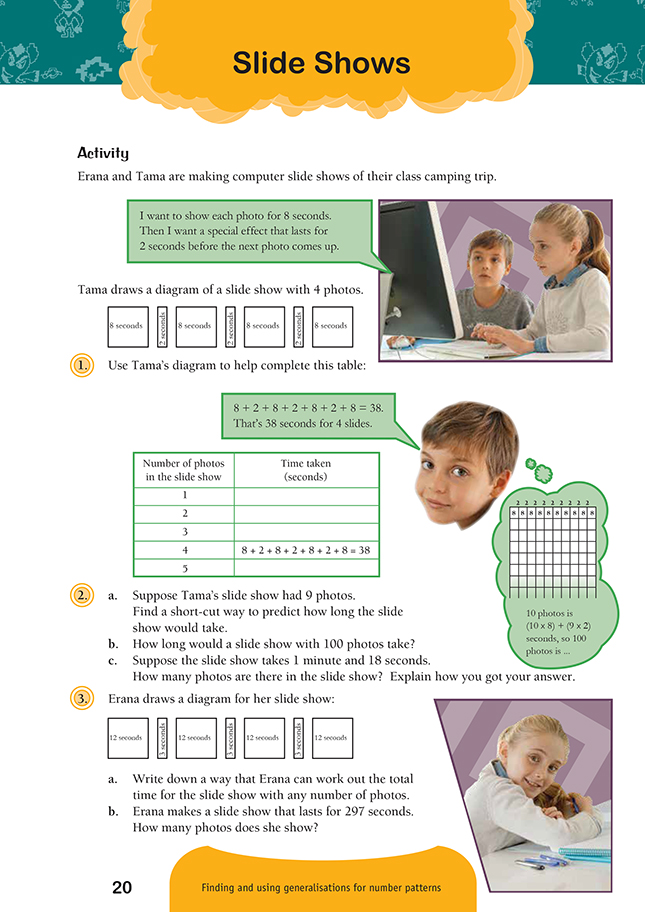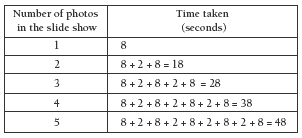This is a level 3 number activity from the Figure It Out series. It relates to Stage 6 of the Number Framework.
A PDF of the student activity is included.
Click on the image to enlarge it. Click again to close. Download PDF (271 KB)
use mental strategies (compatible numbers) to solve problems
Number Framework Links
Use this activity to help the students to apply additive and multiplicative part–whole strategies (stages 5–7).
FIO, Level 3, Number Sense and Algebraic Thinking, Book Two, Slide Shows, page 20
This activity encourages students to think systematically about the structure of a number pattern and to anticipate the result of calculations using identified patterns and rules.
Students need to be at least early additive part–whole thinkers (stage 5) in the domain of multiplication and division to do this activity. They need to understand that multiplication is a quick way of calculating repeated addition, for example, 8 + 8 + 8 + 8 = 4 x 8.
This activity has useful cross-curricular links to the Visual Language: Presenting strand of the English curriculum and would be a useful accompaniment to practical sessions on computers in which students are creating their own slide shows. Talk about computer slide shows that the students have seen or made. If possible, watch one on a computer. Show the students how you can choose the length of time each picture shows for and experiment with some of the transitions. Talk about how some of the transitions are instant and others, such as “dissolve” or “wipe down”, take a couple of seconds, depending on the speed you select. In terms of visual language, you need to discuss the message that might be conveyed by quick breaks and long
breaks, such as “dissolve”.
The diagram and the equation in the table in question 1 are designed to help the students identify patterns in the numbers. For each new photo, 10 seconds are needed (made up of 8 seconds to view the photo and 2 seconds’ transition), apart from the last photo (where no transition follows). Some students may need to draw or model the pattern physically (building from 1 photo to 2 photos and a transition, to 3 photos and 2 transitions, and so on) to help them visualise the structure of the pattern.
For question 2, encourage the students to discuss their strategies in small groups and then report back to the whole group. Use this time to listen to and support the thinking of individuals as they interact with their peers.
The students should find it straightforward to add on 1 more transition and photo at a time to sequentially work out the time needed for 9 photos, but it is important that they look beyond recursive (sequential) rules such as “add 10 seconds” because these rules are only helpful if you know how long the slide show was before you added the extra picture. A generalisation enables students to work out how long any number of slides would take to show, and therefore it is much more powerful. To encourage the students to look towards a generalisation, ask questions such as:
What short cuts could Tama use to speed up the process of adding on 8 + 2 seconds?
Multiplication is a fast way of adding. What could you do instead of adding 8 + 8 + 8 + 8 + 8?
Can you see any groups that Tama could multiply to make a slide show with 5 photos?
“5 groups of 8 and 4 groups of 2: (5 x 8) + (4 x 2)”
“4 groups of 8 + 2 = 10 plus another 8 on the end: (4 x 10) + 8”
“I could imagine another 2 on the end and work out 5 groups of 8 + 2 = 10, then take the 2 off: (5 x 10) – 2.”
Watch for students who assume that if they know a slide show with 5 photos takes 48 seconds, a slide show with double the photos would take double the time, that is, they think a slide show with 10 photos would take 96 seconds, but it would actually take 98 seconds. Challenge their thinking:
Convince me you’re right.
Could you test your strategy on the 2-photo and 4-photo slide shows in the table?
For question 2c, students show a deep understanding of the way the patterns work if they are able to solve the reversed problem using algebraic reasoning rather than simply adding on until they reach 78 by trial and improvement. Ask the students who solve the problem by adding on if they can also find another faster way to solve the problem. Ask students who need support:
How many seconds are there in 1 minute and 18 seconds?
What groups did you find in the table to use in your short cut?
How could you break 78 up into those groups?
Once you’ve broken the 78 seconds up into the same sort of groups you saw in the table, can you use that information to work out the number of photos?
Some possible ideas are:
“I saw groups of 10 made up of 8 + 2 in the table, but the last group didn’t have its 2.”
“I could add that missing 2 onto 78, which would give me 80, and then I could divide by 10 to work out how many groups there would have been: (78 + 2) ÷ 10 = 8 photos.”
“I also saw groups of 10 made up of 8 + 2 in the table but with an extra group of 8 on the end. I could take the 8 off 78, which leaves 70, which could then be broken up into 7 groups of 10. So there’d be 7 photos plus another one in the last 8 seconds, and that’s 8 photos altogether.”
Question 3 is useful for making formative assessment observations as to whether the students can apply the ideas they have been explaining to create rules for similar problems using different numbers.
Extension
Get the students to write their own slide show problems for another group member to solve.
Challenge them to write two types of problem: one where they have to work out how long the slideshow would take if they had pictures and another where they have to work out how many photos are shown in a slideshow lasting seconds. This is another valuable opportunity for formative assessment.
Challenge the students to write a set of instructions for working out the time needed for any number of photos where the times for the photo to show and the transition are not specified.
Here is one possible set of instructions:
• Work out how long it takes to show a photo as well as change over to the next slide.
• Multiply this number by the number of photos you have.
• Subtract one transition time (because you don’t need a transition at the end).
Answers to Activity
1.
2. a. It would take 88 s. Possible short cuts include:
(9 x 8) + (8 x 2), or (8 x 10) + 8, or (9 x 10) – 2.
b. 998 s, which is 16 min and 38 s. This could be worked out using one of the short cuts from 2a:
(100 x 8) + (99 x 2) = 800 + 198
= 998
(99 x 10) + 8 = 990 + 8
= 998
(100 x 10) – 2 = 1 000 – 2
= 998
c. 8 photos. One way to work this out is: 1 min 18 s = 78 s. Each photo takes
8 + 2 = 10 s to show with its transition, apart from the last one, which only needs 8 s.
78 is made up of 7 groups of 10 and 1 group of 8, so there must be 8 photos. Another way is: 78 + 2 = 80; 80 ÷ 10 = 8.
3. a. Generalisations will vary, for example:
• Multiply the number of photos by 15 and subtract 3.
• Work out what 1 less than the number of photos is, multiply this number by 15, and then add on another 12.
• Multiply the number of photos by 12, multiply 1 less than the number of photos by 3, and then add these two answers together.
b. 20 photos. One way to work this out is:
Each photo takes 12 + 3 = 15 s to show with its transition, apart from the last one, which only needs 12 s. 297 is made up of 19 lots of 15 and 1 lot of 12, so there must be 19 + 1 = 20 photos. (Use the fact that 2 x 15 = 30 to work out that 20 x 15 = 300 and adjust from there.) Another way is: 297 + 3 = 300; 300 ÷ 15 = 20.

